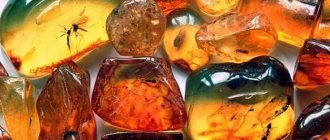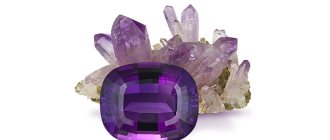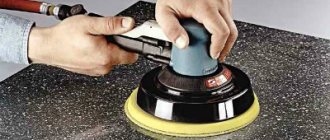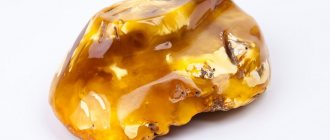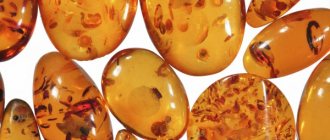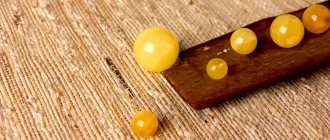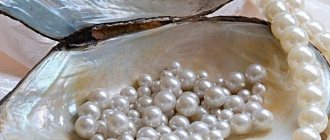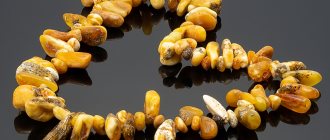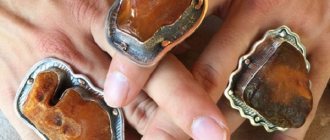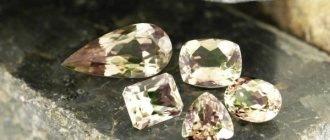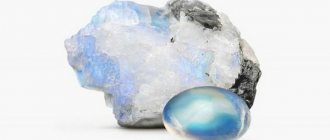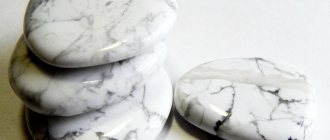Despite the relatively low price of the mineral, counterfeits are common among amber products. Imitations are of no value; most often they deteriorate faster than natural materials.
The lowest quality fakes even look very different from amber, which can put you in an uncomfortable position. However, there are several features that can be used to distinguish an imitation from a mineral.
Amber is a sun stone.
Properties and characteristics of the stone
The properties and characteristics of natural amber are reflected in the table.
| Color | Shine | Stroke color | Transparency | Hardness | Cleavage | Kink | Density | Refractive index of light | Melting temperature |
| Varies from light light yellow to dark brown, with admixtures of red and green, and almost colorless and white varieties. | Smolyanoy | White | Varies from almost completely transparent to opaque | 2-2.5 points; soft material, scratches even with nails if you apply force | Absent | In relatively young samples it is viscous and conchoidal; in older specimens it becomes fragile | May vary: average - 1.05-1.09 per cubic meter. cm, but there are samples with a density of up to 1.3 g per cubic meter. cm | 1,54 | Reaches +350…+380 °C |
General recommendations
There are several general rules and recommendations that allow you to largely understand how to identify real amber from a fake.
- If the tracings and sparkles that are located in the thickness of the stone are tightly packed, uniform and almost identical, then there is a possibility that it is a fake. Most likely burnt. But perhaps it is also calcined amber;
- You should be wary if the color of beads or other products is uniform. There are no transitions or any texture. It's probably a fake. Although there are cases when fakes have a texture characteristic of real amber;
- The appearance of natural stone is more expensive than that of fake stone. Especially when the product has not been subjected to heat treatment. Natural resin has a very interesting color. Has chaotic transitions of shades. The array always contains a unique pattern, characteristic exclusively of natural amber.
But these are all general points. There has not yet been a clear answer to the question of how to distinguish fake amber from real amber. We will correct the situation.
So it is worth recalling the importance of being able to distinguish between fake silver and imitation natural gold.
Signs of real amber
Real amber has an imperfect appearance. There are inclusions in it. This is a relatively light stone. It weighs less than fakes made of glass or other minerals.
The surface temperature of amber is higher than that of imitations. It conducts heat well, but cools quickly.
Plastic, glass and other minerals remain cool even in your hands for a long time. Amber is soft and more easily damaged, so there are many tests to check it, but they can degrade the quality of the natural stone.
Reminder before purchasing
It will not be possible to use many of the listed methods when purchasing. For example, burning amber emits a pleasant aroma, but setting a piece of jewelry on fire in a store will not be allowed. The same situation with a sharply sharpened knife. But there are safe methods to check the naturalness of the stone.
One of the best ways to distinguish real from fake amber is ultraviolet testing. The method is not available at home, but is sometimes used in stores. It is enough to ask the seller for a counterfeit banknote detector to recognize the counterfeit.
To examine the stone externally, you can take a magnifying glass. It helps to carefully examine the color, pattern, find joints in a fake mineral, and see other details. The increase is at least tenfold.
It is often possible to identify fake amber without resorting to complex examinations. The main thing is to study the available methods and take a close look at the decoration.
Ways to check amber in a store
The main ways to check a product in a store are reduced to inspection, checking tactile qualities and assessing the cost. Most often, transparent samples are faked.
Opaque ones are initially of lower quality and are cheaper unless we are talking about unusual specimens, so the production of imitations is impractical.
Appearance
You can distinguish a fake by appearance using the following criteria:
- Inclusions. In imitation they may be completely absent or have an elongated shape. The latter is due to the low strength of the material used to make the fake. Due to this, air bubbles easily moved to the surface. Inclusions get stuck in amber. Air bubbles have a round shape, because due to their high density they cannot quickly move to the surface.
- Cracks and overflows. As the stone matures naturally, irregularities and chips appear. They occur when mineral builds up and layers shift. It is often possible to trace the boundaries of layers as a result of changes in the chemical composition of the materials. Counterfeits are either completely homogeneous or have overly pronounced transitions without layers or cracks.
- Hue. This mineral has pronounced honey, milky and dark brown colors, sometimes with admixtures of green or red. Amber can be bright, but it doesn't look unnatural. The fake contains flashy shades and impurities.
- Pattern shape. Natural samples have a chaotic internal pattern. You can see patterns in fakes.
A drop of amber.
Tactile sensations
Even at the first touch, natural stone feels warm to the touch. It heats up quickly in your hands, but also cools down just as quickly. Plastic and glass are cold. It is almost impossible to distinguish fakes made from resins using this criterion. They have a similar composition, so they resemble the original.
Inclusions
Jewelry with insects inside is often found on sale. Sometimes even small animals get caught in the resin. For example, birds or reptiles.
If an animal gets stuck in natural material, it begins to fight for life: it tries to reach its paws, push off with its wings, etc. As a result, it acquires an uncomfortable, sometimes unnatural, pose.
In the case of fakes, the pose of animals and insects is standard. If it is an ant, its paws are placed almost at the same distance, the body is completely straight, the head is not raised.
This is due to the fact that the animal is placed in the material after its death. There are occasional exceptions when an insect ends up in natural amber already dead, but such cases are rare.
Amber with frozen insects.
Price
The original is often more expensive than the fake. Its price reaches $20 per 1 g. The cost depends on the presence of inclusions and defects, the shape of the sample, the quality of its processing, color and degree of transparency.
The production of imitations is cheaper, and therefore their price is lower. However, sometimes sellers try to sell a fake at the price of the original, so you need to take all indicators into account.
What are imitations made of?
To understand how to distinguish amber from a fake, it is important to know what fakes are made of. Artificial stones are made from resins, plastics and other materials.
Resins
Resins from various wood species are used as raw materials to imitate natural stones. At the same time, fake stones are much softer than the original. If the fake is set on fire, it will not emit the characteristic pine smell.
If you look through synthetic stone into the sun, its uniform texture will be visible. At the same time, the resin, which grows over many years, contains delamination in the structure.
Faturan
This substance is a synthetic analogue of amber resin. It was invented back in the eighteenth century. The original recipe included natural fresh resins. They were fused with the waste that remains after processing amber.
Today faturan is extremely rare. The recipe for its manufacture was lost, and no one has yet been able to restore the proportions of all the components. The Dutch masters managed to get as close to this as possible. They created an artificial resin that had the following characteristics:
- homogeneous structure;
- translucent texture;
- swirls in a structure that resembles cigarette smoke.
Glass
This material is very often used to create jewelry as it can look very attractive. However, the simulation has certain differences:
- glass is considered heavy, and fiberglass is considered lighter than natural amber;
- glass seems cooler when in contact with skin;
- glass has a higher degree of hardness;
- glass can be easily broken, and fiberglass can be damaged;
- the internal pattern has certain differences, and the structure contains small bubbles.
Plastics
Recognizing plastic is not difficult. Imitations of amber from this material began to appear en masse after the end of the First World War. The need for them was associated with a decrease in people's well-being.
However, much has changed since then - plastic has become more diverse, and its quality has made it possible to pass off such jewelry as original. Fakes made of plastic or epoxy resin are cooler than natural crystals.
Synthetic substitutes
To recognize fakes, you need to know what they are made of. The following materials are passed off as natural resin:
- Bernite is a composition based on various polyesters. The substance contains natural, obtained from waste after processing of amber.
- Celluloids - this material includes camphor extract, cellulose, dyes, colloids. Its characteristic feature is considered to be an unnatural shine.
- Bakelite is a phenol-formaldehyde resin that contains dyes. The material is highly durable.
- Polyesters have an unpleasant odor that appears when heated.
Authenticity tests at home
At home, you can carry out several tests that will help you distinguish a fake with a greater degree of reliability. However, some of them can damage the stone.
It should be borne in mind that the physical properties of amber may coincide with resins, so one test will not be enough. It is advisable to carry out several checks and take other indicators into account. Sometimes it is possible to distinguish imitation only in laboratory conditions.
Using salt water
The method is used only if the stone does not have a frame. Most samples have low density, so they float in salt water. To carry out the test, prepare a solution of 8 tsp. salt and 200 ml of liquid.
The spice is completely dissolved in water, then the stone is lowered. Crafts made from bakelite, burnite and glass sink, while amber most often floats. If the mineral is large, take a large container and add as much salt as the water will take.
The test is not considered completely reliable. Some specimens are quite dense, so they sink even in salt water. The lightest samples float in tap liquid.
Real amber will float in salt water.
Electrification
Natural stone is highly susceptible to electrification. For this test you will need a piece of wool or silk. The mineral is rubbed hard against the cloth, then brought to the paper. Natural stone immediately attracts the material to itself.
Using this method, amber is distinguished from copal. It does not become electrified even with prolonged exposure. Plastic can also attract paper, but this ability is less pronounced. To distinguish it from a real mineral, you will need a verified sample or visual inspection.
Natural amber is highly electrified.
Smell when melting
The mineral does not have to be melted. You can rub it hard against your palm to raise the temperature of the stone. In this case, the natural mineral will have a light pine aroma.
The fake resin smells even without exposure to high temperatures. Copal imitations begin to adhere to the skin after heating. Glass fakes have no aroma. Plastic can smell bad.
Additionally, you can bring the product to the fire. Use, for example, a lighter. When it comes into contact with a flame, the natural material will begin to boil and ignite. Black smoke will appear.
Counterfeits are either insensitive to fire or melt much faster. However, this is a traumatic method that will ruin the decoration. An alternative is to use a hot needle.
It will also damage the surface, but the defect will be less pronounced. Upon contact, white smoke should emit from the natural stone and a resinous odor will appear.
Amber is subject to combustion.
Solvent test
Natural stone is more resistant to solvents. As the latter, you can use, for example, acetone. Soak a cotton pad in the liquid and apply it to the surface for 1-2 seconds.
You cannot keep the stone in the solvent for more than 3-5 seconds, as this will ruin its appearance. With short-term exposure, amber remains the same and does not change.
Imitations made from copal deteriorate greatly, their surface becomes dull, and irregularities appear. The color changes. When pressed amber comes into contact with a solvent, it becomes sticky.
Alcohol
Alcohol is used in the same way as a solvent. Some stones are resistant to acetone, but are destroyed when exposed to ethyl alcohol. Other minerals, on the contrary, are resistant to the latter reagent.
Chemical reagents
Alcohol and acetone belong to the list of chemical reagents. Additionally, you can use stearin or ethers. They greatly change the appearance and tactile sensations when interacting with stones.
The mineral may, for example, become cloudy. But the abuse of chemical reagents can also spoil the amber itself, so reagents are used with caution.
Testing with chemical reagents must be carried out with care so as not to damage the stone.
Types of fakes
Since ancient times, people have been trying to reproduce sunstones (the frozen resin of the ancient pine Pinus Succinifera) using improvised means. Here are the most common simulation materials:
- artificial plastics and resins (bakelite, urea, epoxy, polystyrene, acrylic and polyesters). Many of them have negative health effects;
- painted glass or ceramics;
- celluloid and nitrocellulose . Nowadays they are almost never used due to the explosion hazard;
- burnite is “fused” amber, permeated with many decorative cracks. Consists of polyester resins, to which about 5% natural gems are added;
- products from natural resins secreted by the bark of the Agathis dammara tree and other similar plants. As a rule, they are distinguished by increased fragility and duller color;
- varnishes (amber varnish, gedanite, glossite). Contain a certain amount of crushed stones mixed with rosin, turpentine, linseed oil;
- low-quality or “immature” fossil resins (kranzite, burmite, rumenite, copals). Found in Africa, South America, Indonesia, New Zealand, Burma. Such gems are more fragile and softer than real cabochons, and their rough surface is covered with a whitish coating.
| Ambroid - pressed amber | ||
Reconstructed or pressed amber (ambroid) is not considered counterfeit. It is obtained by squeezing small stone chips with a hydraulic vice at a temperature of 200-250° C. This method allows for a more rational use of the extracted raw materials. Refined (boiled in oil) pieces of hardened resin are also considered natural.
The variety of fakes is truly amazing. However, you can still find natural gems among them - and how to do this is described below!
Ultraviolet radiation
If you “illuminate” amber with an ultraviolet lamp, it will luminesce to varying degrees. Transparent amber will give a mystical blue glow of different shades. The less transparent the amber, the weaker the effect of such a glow. Smoky amber of a translucent texture glows bluish, and the structure of any stone under UV rays forms wavy streaks, stripes and transitions from one shade to another. If amber is untreated, it will glow with brown tones. Bakelite under UV rays will not give any glow, and casein will show itself in a bright yellow color.
Of course, when buying jewelry, it is not always possible to conduct one or another experiment with them. But no one will forbid you to closely examine the stones, and the risk of purchasing a fake will be significantly reduced.
